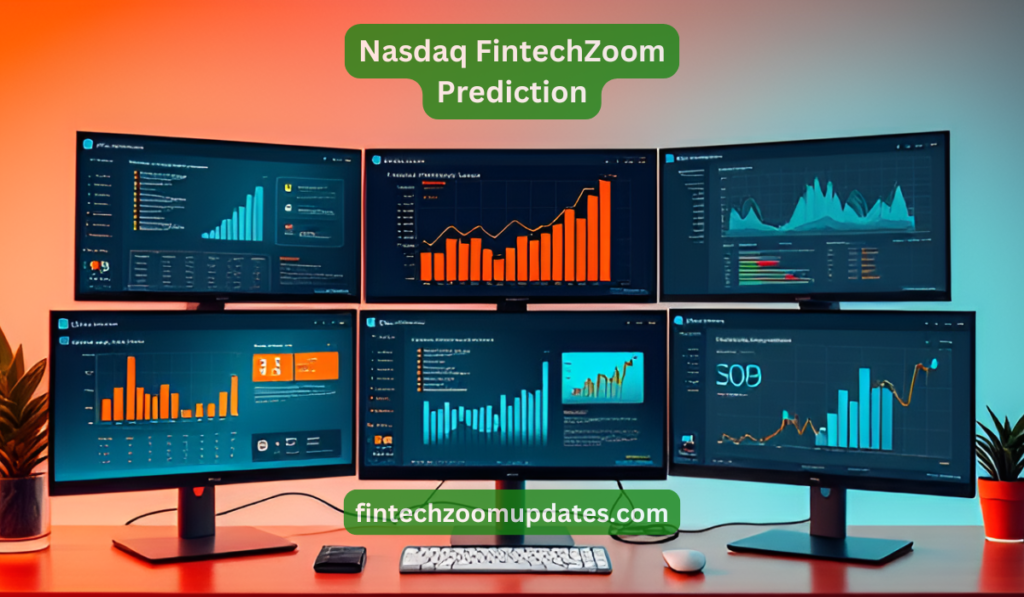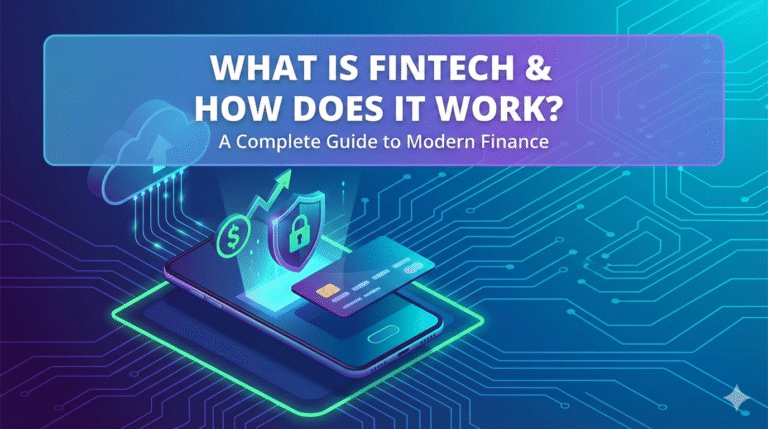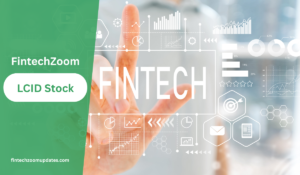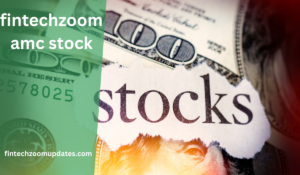Nasdaq FintechZoom Prediction has become a key topic for investors looking to understand market trends. The Nasdaq had an impressive year in 2024, driven by strong earnings from major tech companies like Apple, Amazon, and Microsoft. Their growth helped push the index higher, creating a solid foundation for future investments. However, external factors like inflation and global economic shifts also influenced stock performance, adding some uncertainty to the market outlook.
Nasdaq FintechZoom Prediction for 2025 highlights the growing impact of fintech innovations on the financial sector. Artificial intelligence, decentralized finance (DeFi), and digital currencies are set to transform banking, trading, and investment strategies. The integration of advanced technologies will reshape financial services, creating new opportunities for investors. Regulatory changes and shifts in consumer behavior will further influence market dynamics, making it essential to stay updated on these evolving trends.

Table of Contents
ToggleNasdaq’s 2024 Performance Overview
Let’s start by examining how Nasdaq fared in 2024. Understanding the past guides us toward our future.
Important Stock Trends and Annual Growth Metrics
Thanks to the strong earnings from top tier technology companies, top tier companies like Apple, Amazon, and Microsoft spearheaded this resurgence, and in 2024, the Nasdaq was able to recover tremendously. Apple alone led with a 30 percent rise, while the index overall grew 20 percent, which is a great start for 2025.
| Company | 2024 Stock Price Increase | Key Milestones |
| Apple | 30% | Record iPhone sales |
| Amazon | 25% | Expansion in cloud services |
| Microsoft | 28% | Growth in AI-driven products |
Tech Leaders Stock Issue Performance Comparison
For better illustration, here is a comparison of major tech companies and how the stocks traded in 2024:
| Tech Company | Stock Price at Start of 2024 | Stock Price at End of 2024 | Percentage Increase |
| Tesla | $180 | $270 | 50% |
| $120 | $160 | 33.33% | |
| Facebook (Meta) | $200 | $280 | 40% |
Nasdaq Listings and the Impact of Worldwide Events on The Nasdaq Index
How did global events affect the performance of the Nasdaq? Recovery from the pandemic accompanied by increased consumer activity fueled buying in the stock market. The violence of inflation and geopolitical conflicts contributed to the overall market volatility, though.
Performance of Tech Corporations Along With Their Weighting on The index
Tech corporations notably impacted the Nasdaq as they represented more than 40% of its total market cap. What these companies did within their respective industries adjusted to their performance, meaning they directed the entire index. These firms were greatly watched because their new inventions and innovations could change the game completely.
Key Fintech Trends Anticipated in 2025
Now, let’s explore the fintech trends projected to shape the industry in 2025. These trends are not just buzzwords; they’re game-changers for how we interact with money.
AI-Driven Financial Services and Personalized Banking Solutions
Artificial intelligence is revolutionizing financial services. By 2025, we can expect banks and fintech companies to offer personalized banking solutions powered by AI. Imagine a banking app that knows your spending habits and offers tailored advice—pretty cool, right?
Expansion and Mainstream Adoption of DeFi Platforms
Decentralized finance (DeFi) is also on the rise. It’s predicted that more users will shift from traditional banking to DeFi platforms, attracted by lower fees and greater control over their finances. This shift could redefine how we think about money management.
Emergence of New Digital Currencies and CBDCs
The world of digital currencies is evolving rapidly. By 2025, we’ll likely see more countries adopting central bank digital currencies (CBDCs). These digital forms of money could enhance efficiency in transactions and provide a safer alternative to traditional currencies.
Artificial Intelligence Revolutionizing Financial Services
Let’s delve into how AI technology will change different dimensions of the financial services industry. This technology is not a fad; it is rapidly emerging as something crucial.
Improvement In Customer Services Using AI Chatbots And Virtual Assistants
AI-powered chatbots are now commonplace in customer service. They can answer questions around the clock, enabling them to assist any user at any time. This means no more annoying automated voice systems—how wonderful it is!
AI In Risk Management and Fraud Prevention
AI is also the new trend in risk management as well as fraud prevention. Financial institutions use AI systems to study transaction patterns and can flag potentially harmful actions as they take place. This allows stopping fraud from occurring and is a great relief for banks and customers alike.
AI technology offers customized financial planning and investment opportunities.
Picture having access to your own financial planner. An AI can analyze your current situation to formulate a suitable investment strategy, which means that everyone can have a chance to plan their finances.

Decentralized Finance (DeFi) and Its Market Impact
Now, let’s analyze the growth of DeFi and its potential effects on traditional finance. This is where things get really interesting.
Overview of DeFi Services Like Lending, Borrowing, and Trading
Decentralized finance platforms allow for lending, borrowing, and trading operations without intermediaries. This opens up a world of possibilities for users who want to take control of their financial futures.
Comparison Between DeFi Platforms and Traditional Banking Systems
When compared to traditional banking systems, DeFi platforms often provide lower fees and faster transactions. However, they also come with risks, such as smart contract vulnerabilities and the lack of regulatory protection. Here’s how they compare:
| Feature | DeFi Platforms | Traditional Banking |
| Accessibility | Open to anyone with internet | Often requires extensive documentation |
| Fees | Generally lower | Typically higher |
| Transaction Speed | Instant transactions | Can take days |
| Regulatory Oversight | Minimal | Heavily regulated |
| Security | Smart contract risks | Insured deposits |
Potential Risks and Regulatory Considerations Surrounding DeFi
Despite its benefits, DeFi isn’t without risks. Smart contracts can be exploited, leading to significant losses. As governments begin to catch up on regulations, we could see more scrutiny in this space. Investors must stay informed about these potential changes.
Regulatory Changes Influencing Fintech Evolution
Changes in regulations affect the landscape of Fintech, which is important to note for companies as well as investors.
Expected Policies Changes That Are Likely to Impact Fintech Operation And Compliance.
We expect new policies to be in place for 2025, enforcing regulatory compliance to improve consumer and financial protection. The existing rules on privacy and data protection will likely be more stringent, creating challenges for Fintech companies.
The Consequences of Regulations for Innovations and New Market Entrants.
Regulations are useful but can also be counterproductive to creativity. New entrants are anticipated to have limited spending power, which would reduce rivalry for existing competition. As new businesses are more likely, old ones would cope with losing cash faster.
Trends in Regulations Across Countries and Their Impact on Local Fintechs
As we have seen in previous chapters, there is a growing tendency to standardize legislation across nations. Nations are striving to create unified standards for the functioning of Fintech companies, assisting in relieving the burden of compliance for businesses operating in multiple jurisdictions. This advancement is helpful for most seasoned participants in the industry and encourages emerging fintech players.
Shifts in Consumer Behavior Towards Digital Finance
Understanding consumer behavior is crucial for predicting market trends. As digital finance evolves, so do the preferences of everyday users.
Increased Adoption of Mobile Banking and Contactless Payment Methods
Mobile banking is becoming the norm, especially among younger generations. A recent survey revealed that over 70% of millennials prefer banking via their smartphones. Contactless payments are also on the rise, with estimates suggesting they will account for nearly half of all transactions by 2025.
Growing Trust and Reliance on Digital Wallets and Online Financial Services
Trust in fintech services is increasing. More consumers are relying on digital wallets and online financial services for their daily transactions. This shift indicates a broader acceptance of digital finance in our daily lives.
Demographic Factors Driving Changes in Financial Service Consumption
Different demographics are influencing how financial services are consumed. Younger consumers prioritize convenience and accessibility, while older generations might still value face-to-face interactions. Fintech companies that cater to diverse demographics will likely find greater success.

The Future of Digital and Central Bank Digital Currencies (CBDCs)
Digital currencies and CBDCs are growing and evolving fast. These two driving forces will shape the future global economy significantly.
Some Developments in CBDCs Adoption By Different Countries
Many nations are studying the feasibility of, or have already launched, a central bank digital currency. For example, the digital Yuan by China is already a hit. Other nations like Sweden and the Bahamas are also on board. We expect many more countries to join this list by 2025.
Consequences Resulting From Digital Currencies Toward Inflation, Interest Rate, Monetary Policy, and Overall Financial Stability
CBDCs will probably be one of the drivers that transform monetary policy. They could strengthen the central banks without harming financial stability. Nonetheless, it is a lively discussion how these currencies would affect the inflation or the interest rate.
Also Read Our Article: Investment Fintechzoom: Best Strategies for 2025
Challenges and Opportunities of a Digital Currency Economy
Digital currencies may provide us with great efficiency, but figuring out issues like cybersecurity also becomes a requirement of the economy. Securing innovation will determine the success of the cyber economy.
Embracing Sustainability in Fintech Initiatives
Sustainability is gaining traction within the fintech space. Companies are increasingly recognizing their role in promoting environmental and social goals.
Integration of Environmental, Social, and Governance (ESG) Factors in Fintech Solutions
Fintech companies are starting to incorporate ESG factors into their business strategies. This trend reflects growing investor demand for sustainable practices in the financial sector.
Development of Green Financial Products and Services
Green fintech products are emerging rapidly. From eco-friendly investments to sustainable banking options, these products cater to environmentally conscious consumers. Here are some statistics on the growth of sustainable finance:
| Area of Focus | Market Value (2023) | Projected Growth Rate (CAGR) | Estimated Value by 2025 |
| Sustainable Bonds | $1.5 Trillion | 15% | $2.5 Trillion |
| Green Investments | $700 Billion | 20% | $1.2 Trillion |
| ESG Funds | $1 Trillion | 18% | $1.7 Trillion |
Investor Interest in Sustainable Fintech Ventures
Investor interest in sustainable fintech is on the rise. Investing in companies that prioritize sustainability not only aligns with personal values but also opens up new market opportunities.
Strengthening Cybersecurity Amid Fintech Growth
With fintech’s growth comes new responsibilities. Keeping sensitive financial data secure becomes one of them.
Cyber Crime Capable of Inflicting Cardiovascular Failure on Fintech Corporations
Fintech platforms are constantly at risk of sophisticated cyber attacks. From phishing attacks that aim at getting sensitive information to outright data breaches, the possibilities are borderline endless. It is essential to tackle these threats for security purposes.
Read Our Article: Fintechzoom.com CAC 40: Today’s Market Updates & News
New Technologies And Measures to Combat Financial Cyber Warfare
More advanced measures are needed to stop cyber warfare. Investing in multi-factor identification, transaction encryption, and security checks regularly would make a massive difference in the chances of getting breached.
Regaining Users’ Trust Has Never Been More Essential, Therefore Security Measures Need To Automatic
Ignoring the reasonable measures to protect data can seriously compromise consumers’ trust. Trust is one of the most important factors when dealing with users, and being straightforward regarding security policies can increase the chance of gaining users’ trust.

Collaborations Between Fintech Firms and Traditional Banks
We’re witnessing a surge in partnerships between fintech companies and traditional banks. These collaborations aim to combine the best of both worlds.
Mutual Benefits of Collaborations, Such as Innovation and Expanded Customer Reach
Fintech firms often bring agility and innovation, while traditional banks provide established customer bases and regulatory knowledge. Together, they can offer enhanced services that benefit everyone involved.
Challenges Faced in Merging Fintech Agility with Traditional Banking Infrastructure
While these partnerships can be fruitful, challenges exist. Integrating old systems with new technologies can be complex. Success depends on effective communication and a willingness to adapt.
Case Studies of Successful Fintech-Bank Partnerships
For instance, the collaboration between Goldman Sachs and Marcus Bank showcases how traditional banks can leverage fintech innovations to offer personal loans more efficiently. Similarly, partnerships like PayPal and various banking institutions highlight how fintech solutions can enhance payment processing.
Projected Performance of Leading Fintech Stocks
Let us highlight what the most relevant fintech stocks can be projected for the year 2025.
Noted Predictions for Leading Fintech Stocks from Nasdaq
Familiar names like Square and PayPal are on the radar of analysts along with other emerging players in the field. There is optimism for continuous improvement due to the increasing normalization of digital finance services.
The Impact of Technology and the Economy on Stock Value, as well as Their Demand, Supply, and Valuation Criteria
Market factors like technological progress, economic conditions, supply and demand, will affect stock evaluations. Investors who want to enhance their chances to succeed in the markets will need to pay attention to these changes.
Major Business Investment Opportunities Fintech Industry, Other Risks Possibilities
As with other industries, the fintech industry can more than hold one’s attention for investment purposes. However, there are risks. Volatility in the market and regulatory compliance issues can plague some of the top firms. Always remember to conduct thorough research.
Innovations Transforming Payment Systems
Payment systems are evolving rapidly, thanks to emerging technologies.
Rise of Contactless and Mobile Payment Solutions
Contactless payments and mobile solutions are becoming increasingly popular. In 2025, we can expect them to dominate the market, with consumers preferring the convenience that these options provide.
Integration of Blockchain Technology to Enhance Payment Security and Efficiency
Blockchain technology is being integrated into payment systems to enhance security and efficiency. This technology provides a transparent method of processing transactions, minimizing the risk of fraud.
Future Prospects of Biometric Authentication in Payment Processes
Biometric authentication, such as fingerprint scanning and facial recognition, is on the rise. These methods will likely become standard in payment processes, adding another layer of security for consumers.

Evolution of Investment Platforms in the Digital Age
Modern investment platforms are constantly evolving to advance the needs and expectations of newer age investors.
Growth of Robo-Advisors and Automated Investment Services
Robo-advisors are redefining investment management. Their automated, algorithmic financial planning and investment services make it possible for so many people to manage their wealth.
Impact of Social Trading Platforms on the Investment Landscape
Social trading platforms give anyone the chance to follow and copy the trades of more experienced investors. This allows easier access to advanced trading tactics.
Expansion of Fractional Investing and Accessibility for Retail Investors
Retail investors now have a stake in the game. This lets people buy expensive stocks without having to purchase a whole share—perfect for new investors. By allowing lower investments, the stock market will get more people from the bottom tier of investors.
Conclusion
As we step into 2025, the Nasdaq is set to play a pivotal role in shaping the future of fintech. The trends we’ve discussed, from AI innovations to the rise of DeFi and digital currencies, highlight a landscape rich with opportunities. Investors and financial institutions must stay informed to navigate these changes effectively.
With continuous advancements in technology and shifts in consumer behavior, there are countless prospects for growth in the fintech sector. Exciting developments lie ahead—let’s remain optimistic and ready for what’s to come!
Frequently Asked Questions (FAQs)
Is Zoom a long-term buy?
Detailed Explanation Zoom still being one of the key candidates with respect to investment, its growth needs to come from its market demand, competition, and how well it innovates in the remote communication sphere.
What is the future price prediction for the Nasdaq?
Detailed Explanation Nasdaq’s future price is affected by the current economic standing, interest rates, and most of all, the performance of the tech sector. It is believed that the growth is going to be moderate – strong in 2025.
What is the Nasdaq forecast for 2025?
Detailed Explanation It is predicted that the Nasdaq would witness consistent growth owing to artificial intelligence, Fintech and digital commodities. Nonetheless scope for increased market risks and economical concerns will be present.
What is the target price for Nasdaq Meta?
Detailed Explanation The target price of meta is based by other factors which include advertising revenue, development in the metaverse, and adoption of AI. This gives access to a lot of data which yields a wide selection of guesses from them.
How will AI impact fintech in 2025?
Detailed Explanation AI will automatically detect fraud, control investment strategies, and boost customer support in financial services while increasing overall efficiency and innovation.




















